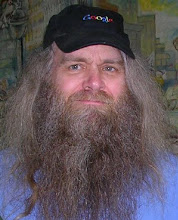(also regrettably compressed)
installment
we replaced the
cross-section neural map
with a cross-section
radial ontology
where simple common stories
are closer to the center
and complex rare ones
nearer the rim
but we have a choice
in how we measure
common-ness
if 9 people are never hit
by a falling star
but one is hit ten times
we can call that rare
or not
so this time we choose rare
and say that anyone hit
at least once
is experienced
and anyone who hasn't been hit
is innocent
(for that specific story)
now because we assign
each story's distance from the center
based on how common it is
(today, in the second sense)
we can identify a band
halfway out
where exactly half of all people
have had those experiences
and the disk inside that band
we'll color yellow
(leaving the outside black)
and it will represent
the character of Everyman
(HCE in Finnegans Wake)
sharing just those stories
shared by the average jo
and we can contrast its averageness
with the slightly different averagenesses
of the average male and the average female
coloring green those stories
within the yellow disk
that an average female (or male)
doesn't share
and red
those stories outside the yellow disk
that an average female (or male) does experience
unlike genderless average jo
or we can look at averageness by age
and mark green or red
those experiences
not yet or already shared
by a specific age
so that a child is born mostly green
innocent of all experience
and the yellow spreads outward
from the center
as they age
(beyond a certain age
the average survivor
may have experiences
unknown to average jo
and these can appear
as red regions
outside the yellow circle)
innocent individuals will be
greener than average
experienced ones redder
branches in particular regions of spacetime
may share local 'experience schedules'
perhaps environmentally based
or culturally based
